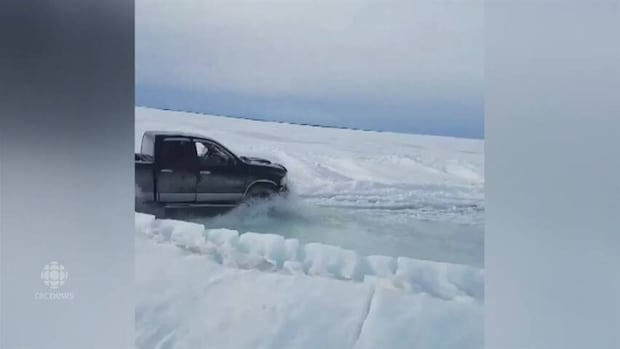Calls for all-weather road to Wollaston Lake renewed
Chief Bart Tsannie said the community has been pushing for an all-weather road for 20 years

Leaders and residents from Wollaston Lake and Hatchet Lake Denesuline Nation are renewing their calls for an all-weather road to their communities.
Edward Benoanie, whose family runs a business in the Wollaston Lake region, said the ice road that connects the community to the rest of the province wasn't open for long this year.
"[The ice road] opened late February, and that's really late," Benoanie said. "Usually we're open on the second or third week, in good years, in January."
The provincial Ministry of Highways officially closed the road in early April. Benoanie said community members barely got the supplies they needed before the shut down.
Despite the closure, some people are still using what's left of the road, leading to safety issues.
Benoanie said people have done their best to maintain the road for smaller, more lightweight vehicles like snowmobiles in the last two to three weeks, but some people are taking chances in larger vehicles.
"These young people haven't been taught how to be out there, and they go, they just go over these pressure ridges," Benoanie said. "You do not pass pressure ridges or go over pressure ridges without checking the ice."
He said a recent snowfall makes crossing even more dangerous, as pressure ridges are not visible and therefore easier to fall into.
The ice road is the only way to access the communities in the winter aside from flying. In the summer months people also use boats or a community barge.
Benoanie estimated it costs around $1,500 to haul a few thousand pounds of goods in the air.
"We're tied to one plane, a nine-seater, for 2,000 people," he said.
Lobbying efforts ongoing: Chief
Hatchet Lake Denesuline Nation Chief Bart Tsannie said his community has been pushing for an all-weather road for the last 20 years.
"Already in the last few days we've had a couple of snowmobiles go through the ice," Tsannie said.
In the past, people have died trying to make the passage.
Tsannie said he's seen little to no progress on making the all-season road a reality from either level of government in the last year.
He said a road would have many benefits for the community. With air being the only consistent access for a majority of the year, everything — housing supplies, groceries, fuel — is costly.
"To bring a jug of milk into our community, just the freight costs close to $10," Tsannie said.
Gas is currently sitting around $1.70 per litre. Tsannie said that price is only likely to go to more than $2 per litre in the summer months.
Tsannie called on the premier to take action.
"Scott [Moe] needs to understand where we come from here, too," he said. "He's the premier for all Saskatchewan and we can't be forgotten."

Road promised in 2008 never happened
Doyle Vermette, NDP MLA for Cumberland, agreed that the road should be built.
"It's for safety and economics and it's the right thing to do." Vermette said.
He pointed to a 2008 promise by the Sask Party government to start work on the road that was later reversed
"I'm frustrated. I'm hearing from the leadership they're frustrated," Vermette said.
Ministry waiting for agreement with feds
Doug Wakabayashi, a spokesperson for the Ministry of Highways and Infrastructure, said people using the closed ice road are doing so at their own risk.
"It's especially risky because at this time of year as the ice starts to melt, ice conditions can change really, really quickly depending on weather conditions," Wakabayashi said. "What looks like it might be fairly solid today, it could be completely different in a relatively short period of time."
Wakabayashi said there is a three-phase plan to build a road ready to go, but that the province is waiting to strike an agreement with the federal government.
The first phase would be the construction of an overland winter road, eliminating the need for an ice road. The second phase would see that road upgraded to a seasonal road that would operate for 10 months a year. The final phase would see the road upgraded to an all-weather road to Wollaston Lake.
"In 2017 we submitted a funding application to the federal government that would allow us to move forward on phase one," Wakabayashi said.
He said the ministry is looking to have the federal government cover the majority of the construction costs while the province would chip in about $250,000. The final two phases would be funded through the ministry's capital planning process, according to Wakabayashi.
The province would then assume the costs of long-term operation and maintenance of the road.

Wakabayashi said that even if federal funding for phase one is secured, there's still design work that needs to be completed.
"Also, in that area of the province, it is a challenging environment to do construction in," Wakabayashi said. "Staging construction, depending on time of year, might take some time as well."
So far, the centre line for the proposed road has already been found and there has been some brush clearing along it's proposed path.


